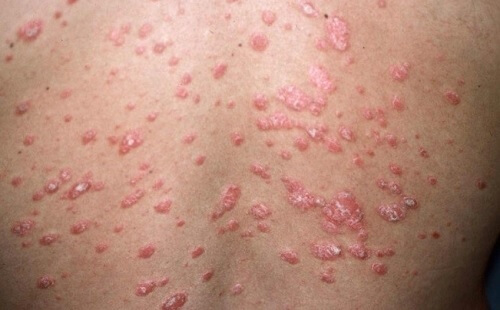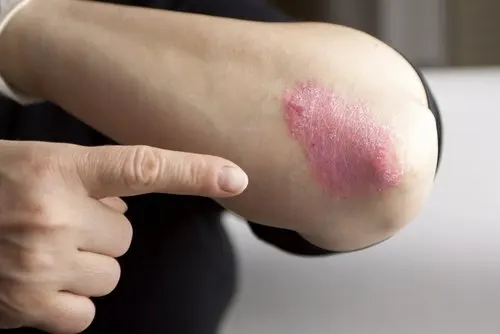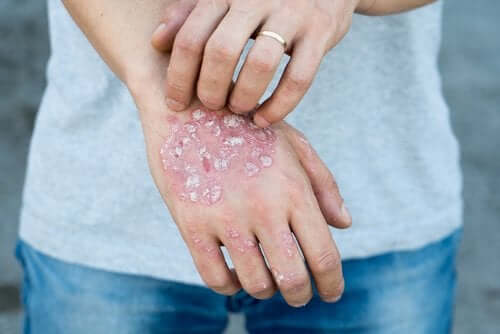What Is Psoriasis and What Are the Different Kinds?


Reviewed and approved by the doctor José Gerardo Rosciano Paganelli
Psoriasis is a chronic skin disease that commonly causes itchy red spots. It can also cause “scales” that vary between white and silver tones, depending on the severity of the condition and the type of psoriasis.
It’s a fairly common condition characterized by the acceleration of the lifecycle of skin cells. In other words, cells accumulate rapidly on the surface of the skin.
That makes the layers of the skin regenerate faster than the normal cell regeneration rate. This ends up creating skin lesions that tend to cause itching and irritation.
The problem is that, as this is a chronic disease, there is no cure for psoriasis. Therefore, treatment is aimed at controlling symptoms. Apart from the pharmacological treatment recommended by a dermatologist, some lifestyle changes can also be helpful.
What are the types of psoriasis?

Psoriasis is usually hereditary and is more likely in men than women. That means that if there’s no history of it in your family, your chances of getting it are extremely low.
On the other hand, it is a chronic disease that can appear and disappear. The main goal of treatment is to reduce the rapid growth of skin cells, although this depends on the type of psoriasis.
There are several known types of this disease. To adequately treat it, a dermatologist will perform a series of tests to detect the type of psoriasis.
Plaque psoriasis
This is the most common form of psoriasis. It gets its name from the fact that it causes a build-up of plaque on the skin. It usually appears on the knees, elbows, face, ears, and back.
It starts as a regular rash but doesn’t go away when you use over-the-counter creams. The rash then turns a reddish color, with a flaky texture. There are also patches of skin that have defined edges on the rash.
Plaque psoriasis causes a lot of itching and in some cases bleeding from dryness or excessive scratching. If it’s in your scalp, you’ll have white scales that look like dandruff.
If it’s in your nails, then they’ll start to chip and can even come off completely in some cases.
Read also: How to Deal with Psoriasis in Children
Guttate psoriasis
Guttate psoriasis is more common in people younger than 30 years old. This type of psoriasis usually produces small red spots on both the torso and limbs. Luckily, it doesn’t cover a large area.
It can also affect the ears, face, and scalp. It also causes lesions, though they aren’t as thick as the ones you get from plaque psoriasis.
People who are carriers of strep or have a chance of inheriting this condition usually develop it when exposed to cold climates because they dry out the skin.
Pustular psoriasis

This type of psoriasis mainly affects adults. It’s characterized by the following:
- Formation of blisters or white pustules of non-infectious pus, along with redness in the surrounding skin.
- The skin is usually red before the blisters start forming, and is normally itchy and painful in the affected area.
Erythrodermic psoriasis
Experts consider this one of the most dangerous forms of this disease. It covers large areas of skin with reddish spots and can happen alongside pustular psoriasis.
It’s more common in people who have unstable plaque psoriasis, where the lesions last indefinitely.
Keep reading: Scalp Psoriasis – Symptoms and Treatment
Other types of psoriasis
- Reverse psoriasis: This type of the disease is common under folds of the skin, like the armpits, groin, or under the breasts. It’s especially uncomfortable because sweat in these areas keeps the skin very sensitive. It usually appears in large patches, but there are no scales in this type of psoriasis. It’s also easy to spot and covers large areas in the folds of the skin.
- Nail psoriasis: When the nails itch, develop an irregular surface, or come away from their root, it’s probably nail psoriasis. It’s usually similar to scalp or plaque psoriasis. Your symptoms may include irregularity in the nail’s surface, splinters in the nail, or the entire nail coming off.
- Scalp psoriasis: This type of psoriasis is often confused with serious dandruff problems. People who have other types of psoriasis normally develop this type too. It starts with fine scales, then denser, thicker scales end up forming. They can spread throughout the scalp and nearby areas such as the neck, ears, and forehead.
Do you have any of these symptoms?
Your immune system is very different from other people’s, and different medications work better for some than others.
Therefore, if you think that you have some of the symptoms described, it’s best to consult with a dermatologist. They will be able to recommend the most appropriate treatment.
All cited sources were thoroughly reviewed by our team to ensure their quality, reliability, currency, and validity. The bibliography of this article was considered reliable and of academic or scientific accuracy.
- López-Estebaranz, J. L., de la Cueva-Dobao, P., de la Torre Fraga, C., Galán Gutiérrez, M., González Guerra, E., Mollet Sánchez, J., & Belinchón Romero, I. (2018). manejo de la psoriasis moderada-grave en condiciones de práctica habitual en el ámbito hospitalario español. Actas Dermo-Sifiliográficas. https://doi.org/10.1016/j.ad.2018.02.015.
- Saraceno, R., Chiricozzi, A., & Chimenti, S. (2015). Psoriasis. In European Handbook of Dermatological Treatments, Third Edition. https://doi.org/10.1007/978-3-662-45139-7_81.
- Capon F. (2017). The Genetic Basis of Psoriasis. International journal of molecular sciences, 18(12), 2526. https://doi.org/10.3390/ijms18122526
- Badri, T., Kumar, P., & Oakley, A. M. (2020). Plaque psoriasis. StatPearls (). Treasure Island (FL): StatPearls Publishing. Retrieved from http://www.ncbi.nlm.nih.gov/books/NBK430879/
-
Saleh D, Tanner LS. Psoriasis, Guttate. In: StatPearls. Treasure Island (FL): StatPearls Publishing; 2020 Jan-. Available from: https://www.ncbi.nlm.nih.gov/books/NBK482498/Benjegerdes, K. E., Hyde, K., Kivelevitch, D., & Mansouri, B. (2016). Pustular psoriasis: pathophysiology and current treatment perspectives. Psoriasis (Auckland, N.Z.), 6, 131–144. https://doi.org/10.2147/PTT.S98954
This text is provided for informational purposes only and does not replace consultation with a professional. If in doubt, consult your specialist.








